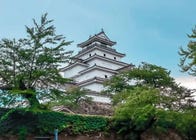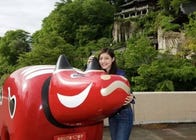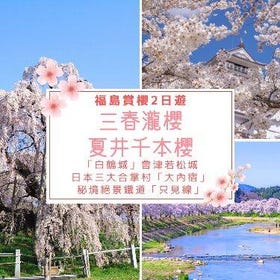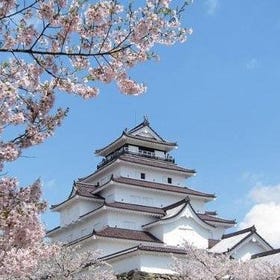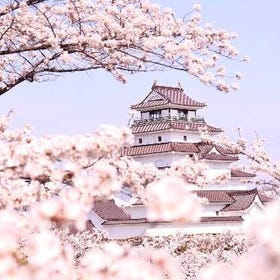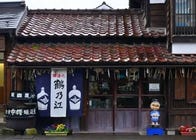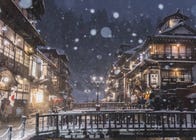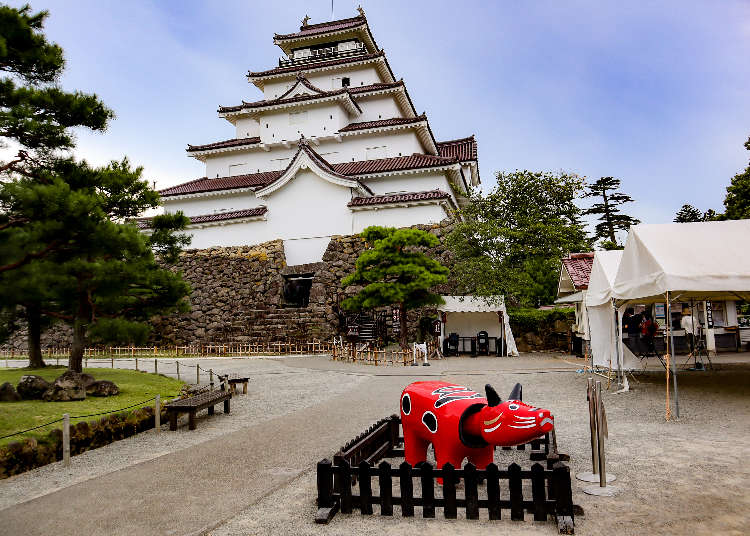
Aizu-Wakamatsu Guide (Fukushima): A Day in the City of Sake and Samurai
- Written by: Sarah Dean
Plan your perfect trip to Aizu-Wakamatsu with our insider’s guide. Discover the top historical sites, local specialties, and unique experiences while making memories to last a lifetime.
North of Tokyo, in the mountains of Fukushima Prefecture, lies the small city of Aizu-Wakamatsu. Chock-full of preserved historical sites, rich samurai culture, and award-winning local sake - but without all of the crowds - Aizu-Wakamatsu is a no-brainer when it comes to filling up your itinerary with unique destinations in Japan. Let us help you plan your next trip and hit all of the local favorites with this insider’s guide to the sake and samurai culture of Aizu-Wakamatsu.
(Main image: Expedition Japan)
What makes Aizu-Wakamatsu special?
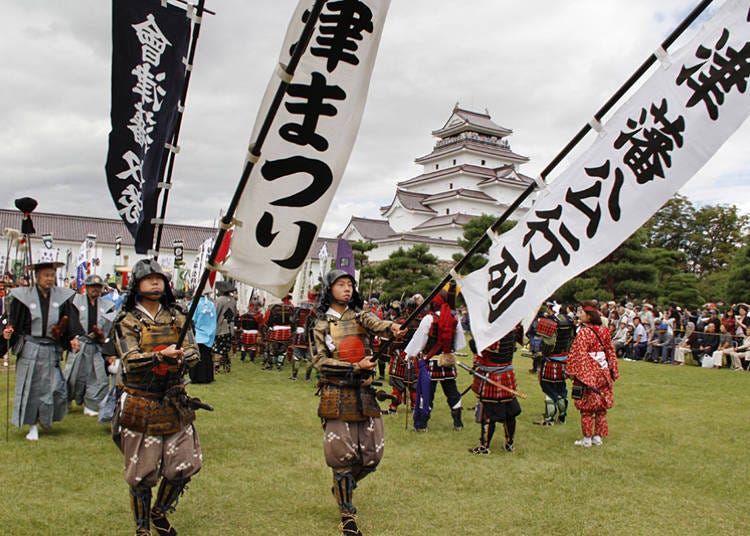
Three things: Samurai, sake, and ease of travel.
Owing to its ideal location surrounded by mountain ranges, Aizu-Wakamatsu was one of the last samurai strongholds of the Edo period (1603 to 1868) and played a critical role during the Boshin War, a civil war that ended in the fall of the samurai.
The Aizu Domain was ruled from Tsurugajo Castle and the once-bustling castle town below evolved into the Aizu-Wakamatsu we know today, leaving behind historic samurai residences, old storehouses and sake breweries, and other unmistakable remnants from its feudal past.
The pure water flowing from the surrounding mountains also created the perfect environment to grow top-quality rice, a skill which the castle town residents quickly honed into brewing famously smooth Aizu sake.
While sake is produced all over Japan, the quality of Aizu-Wakamatsu water and rice cannot be replicated, and you can sample premium sake straight from the source at many of the breweries across town.
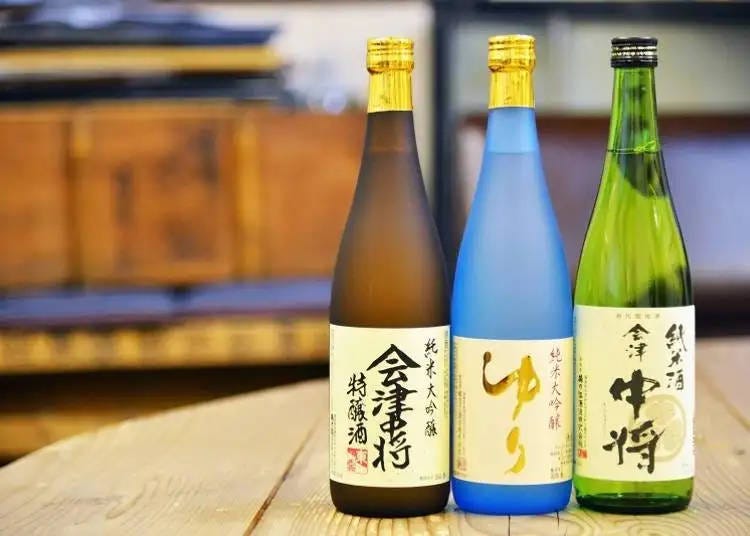
To top it all off, Aizu-Wakamatsu has some of the most convenient public transportation we’ve ever seen, thanks to a sightseeing bus that constantly runs a loop of all of the inner-city tourist destinations.
Forget about hailing a taxi or making complicated train transfers, families and solo travelers alike can travel with ease throughout the city.
How to get to Aizu-Wakamatsu
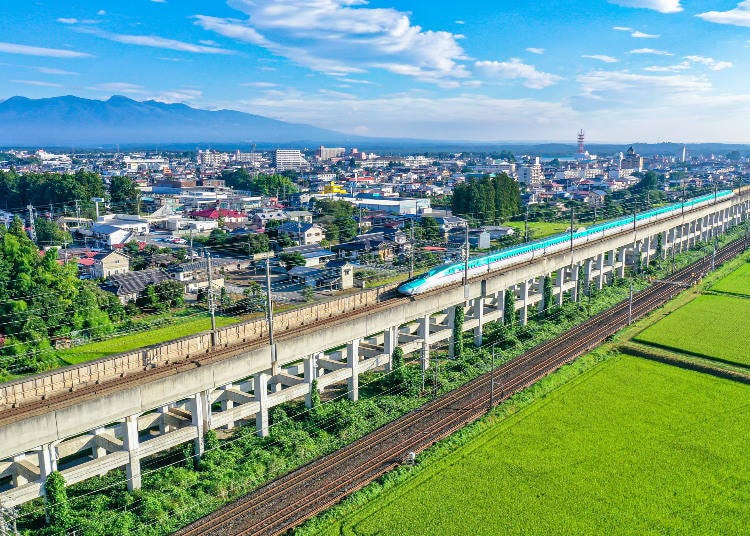
From Tokyo, it takes approximately 3 hours by train to reach Aizu-Wakamatsu, including one transfer.
By rail From JR Tokyo Station, take the JR Tohoku Shinkansen “Yamabiko” to JR Koriyama Station (8,740 yen/1 hour 20 minutes). From JR Koriyama Station, transfer to the JR Ban'etsu West Line towards Aizu-Wakamatsu and disembark at JR Aizu-Wakamatsu Station (1,170 yen/1 hour 15 minutes).
Fares are covered by the JR EAST PASS (Tohoku Area), the JR East-South Hokkaido Rail Pass, and the Japan Rail Pass.
How to get around Aizu-Wakamatsu
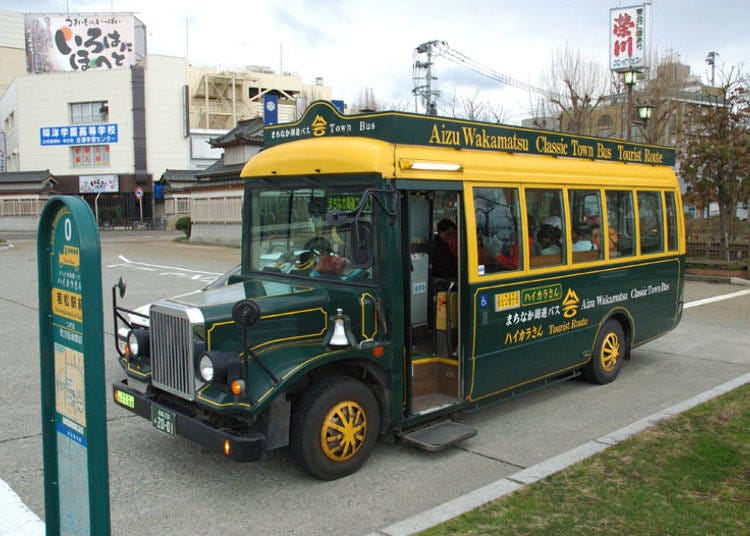
The Aizu Bus sightseeing loop bus is the simplest way to get around once in Aizu-Wakamatsu. Every location in this article is accessible by the loop bus, with the nearest bus stop listed for your convenience.
The bus runs in a counter-clockwise loop on the Haikara-san Line every 30 minutes and clockwise on the Akabe Line every 60 minutes, stopping at 39 stops along the main tourist route. Haikara-san Line bus stops are numbered H1 through H39 and Akabe Line bus stops are numbered A1 through A39.
One-day bus passes are sold for 600 yen/person (300 yen for elementary school students) at the Aizu Bus Ekimae Information Center in front of Aizu-Wakamatsu Station. Showing your pass at the entrance of certain attractions, such as Tsurugajo Castle Tower, will even get you a discount on admission!
Check the map here for the bus route and to see which locations offer discounts: Sightseeing by Haikara-san & Akabe Town Bus is very convenient.
What is there to do in Aizu-Wakamatsu?
With plenty of sights to see and local specialties to try in Aizu-Wakamatsu, choosing where to go can quickly become overwhelming!
We’ve put together a simple course of places to visit in Aizu-Wakamatsu, each easily accessible on the sightseeing loop bus.
Start at Aizu-Wakamatsu Station and follow the order of this list, or start anywhere on the loop to begin your journey!
1. Suehiro Sake Brewery: Free Tours and Tasting at a Historic Brewery
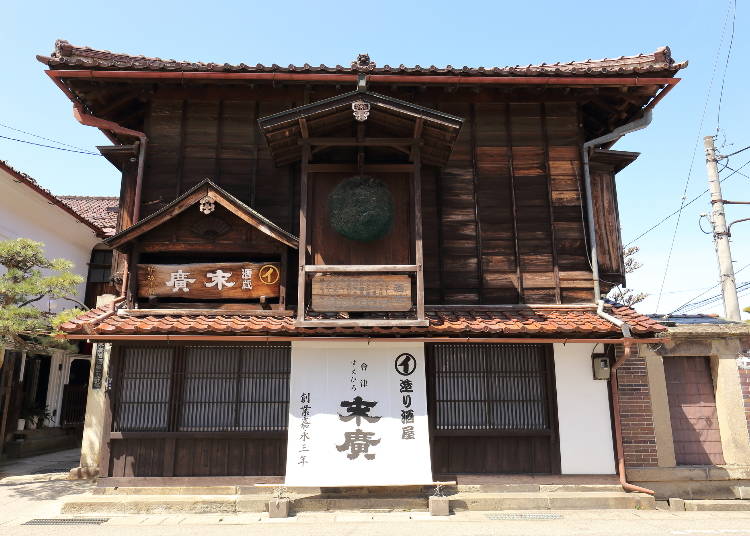
Nearest Bus Stop: Yamatomachi H8 (1-minute walk)/Otonamachi A31 (2-minute walk)
Established in 1850, this brewery has been managed by seven successive generations of the local Suehiro family. Their award-winning sake is exported all over the world, and the friendly staff offer free tours of their brewery. Tours are in Japanese, so we recommend bringing a bilingual tour guide along to get the most out of the experience.
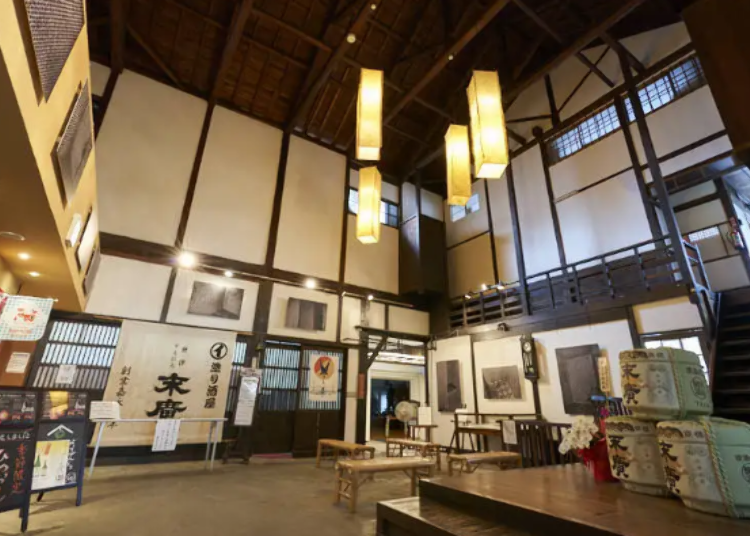
A tour of the brewery takes about 30 minutes, where you will visit the production warehouse and learn about the water-controlled cooling system, the rice used to make the sake, and how the sake itself is made before ending with a complimentary sake-tasting experience. Suehiro usually offers five or six kinds of sake that you can try, so you can compare and decide your favorite type before purchasing a bottle to take home if you’d like.
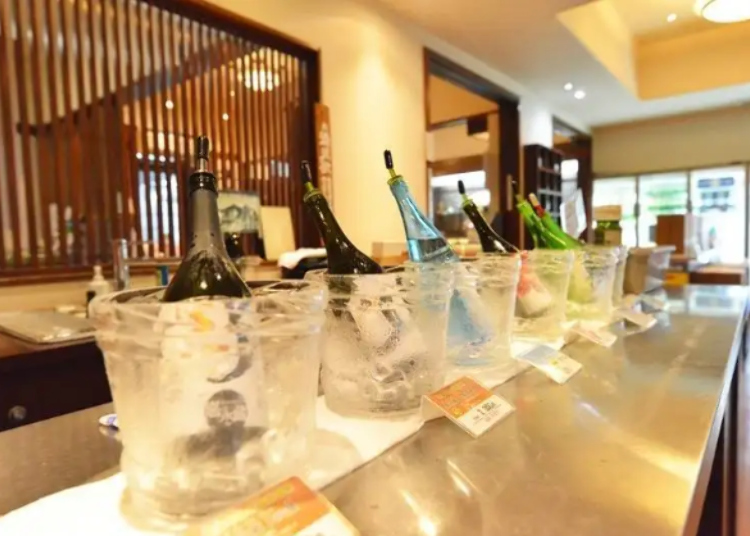
To participate in a tour, call ahead and check availability before visiting the brewery (in Japanese only). Drop-in visitors are also welcome to enter the brewery and purchase sake without participating in a tour.
-
Suehiro Sake Brewery末廣酒造 嘉永蔵
- Address 12-38 Nisshinmachi, Aizuwakamatsu, Fukushima 965-0861
-
Nearest Station
・Hours: Open daily 9:30 AM - 4:30 PM
- Phone Number 0242-27-0002
Website: http://www.sake-suehiro.jp/
2. Tsurugajo Castle: The site of the Samurai’s last stand
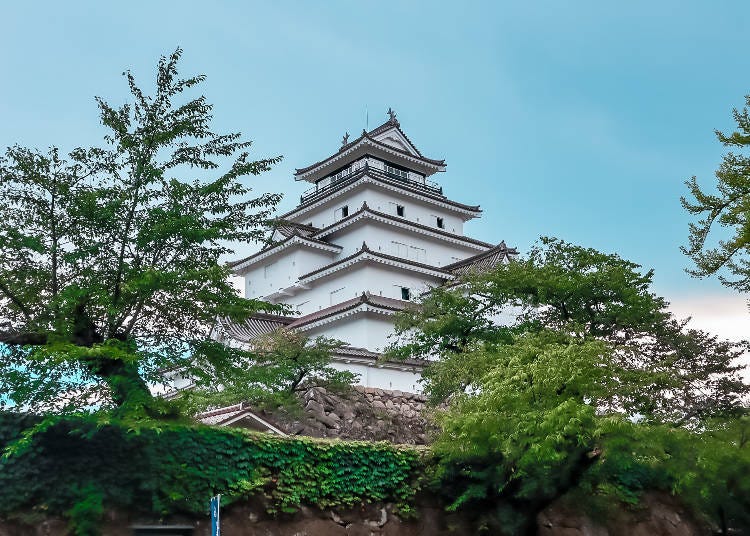
Nearest Bus Stop: Tsurugajo Iriguchi H14/A27 (5-minute walk)
Selected as one of the Top 100 Japanese Castles and home to the last courageous stand of the samurai of the Aizu Domain, this magnificent castle is a testament to the loyalty and perseverance of Aizu samurai.
In late 1968, the Imperialist Satcho Alliance attacked the castle in a brutal onslaught during what came to be known as the Boshin War.
Despite the Imperialist forces’ use of Western artillery, the castle and samurai within fought bravely and withstood the siege for over a month, only surrendering when they accepted that there was no hope left.
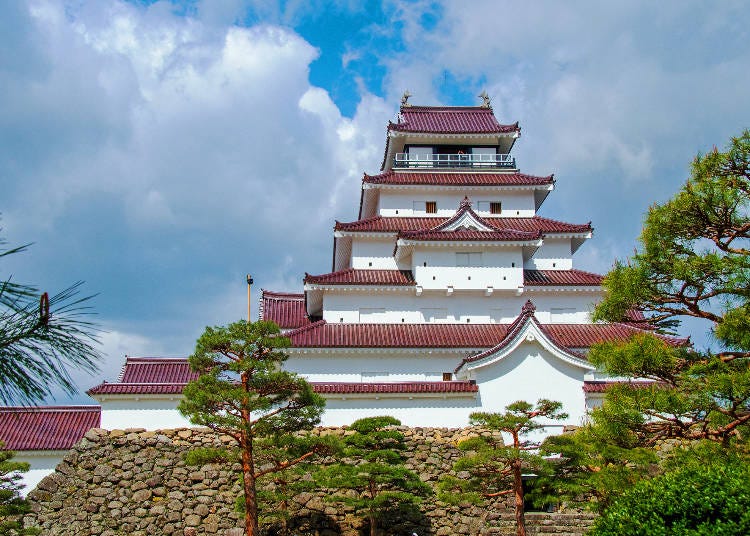
While the castle itself is a reconstruction completed in the 1960s, the stone gates are original, unable to be destroyed by pro-Imperial Court sieges. The burgundy-tiled roof is the only one of its kind in Japan, painted the same color that the castle town residents would have looked up at every day.
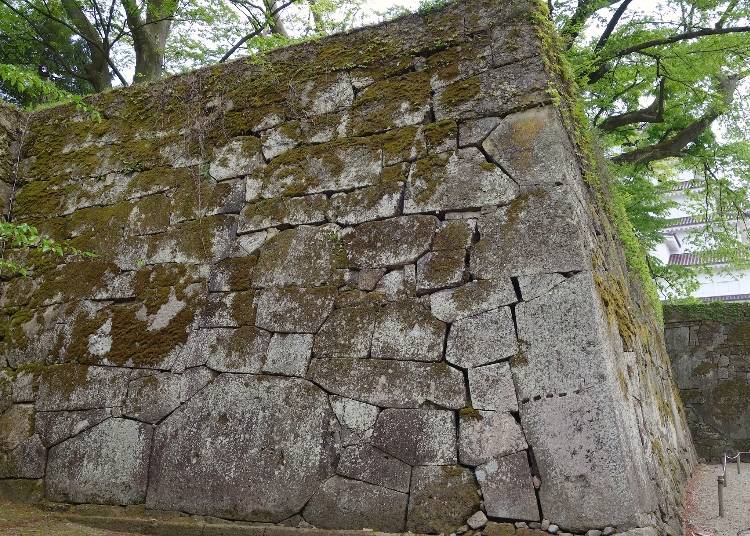
Visitors can climb to the top floor of the castle for a panoramic view of the surrounding mountains and the city below, and enjoy the attractive castle museum featuring real samurai armor, weapons, and other historical artifacts.

For a truly special experience, we recommend ending your visit to the castle with a cup of authentic matcha green tea at Rinkaku Japanese Tea Room.
Located within the castle grounds, this tea ceremony room was built by the lord of Aizu for the son of the famous tea master Sen no Rikyu.
The tea house features traditional tatami straw mats, a thatched roof, and a beautiful Japanese garden, perfect for gazing at while enjoying some green tea.
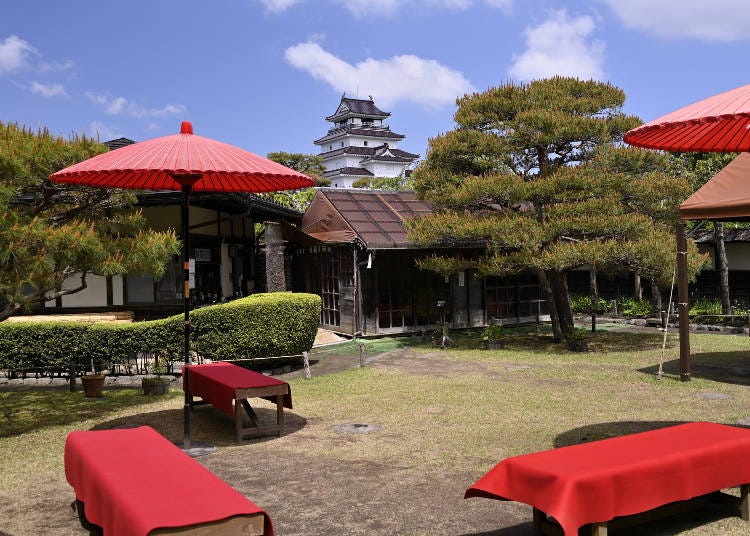
-
Tsuruga Castle鶴ヶ城
- Address 1-1 Otemachi, Aizuwakamatsu, Fukushima 965-0873
- Phone Number 0242-27-4005
Website: http://www.tsurugajo.com/
3. Aizu Bukeyashiki: Walk through an authentic samurai village

Nearest Bus Stop: Aizu Bukeyashiki H24/H30/A11/A17 (1-minute walk)
This open-air museum consists of reconstructed samurai residences from the Edo period, the pinnacle being the mansion of Tanomo Saigo, chief advisor to the Aizu Clan. Featuring 38 rooms, the complex is filled with wax figures depicting the everyday lives of samurai families.
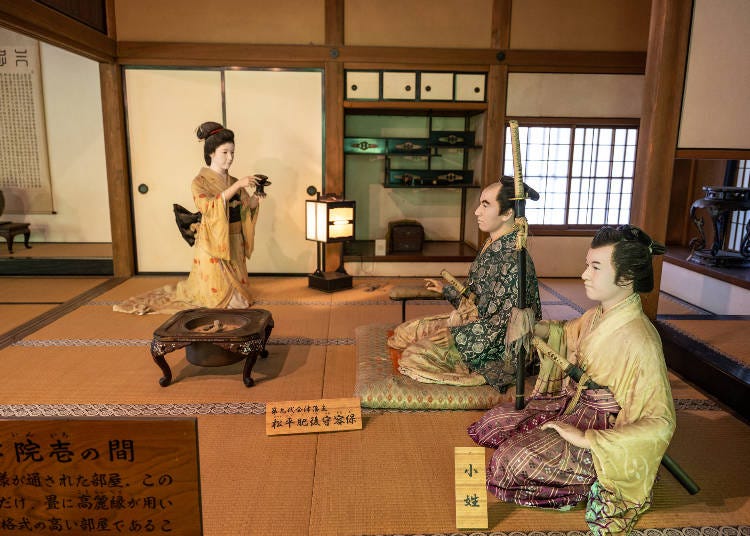
Walking through the museum, you will find Japanese gardens, a teahouse, a rice mill, and a bailiff’s office, among other historical reconstructions.
Also on-site is a souvenir and crafts shop featuring handmade items from Aizu-Wakamatsu and various activity workshops such as archery (200 yen/4 arrows), Aizu traditional akabeko (legendary red cow) figurine painting (1,250 yen), and traditional okiagari-koboshi doll-making classes (1,250 yen).
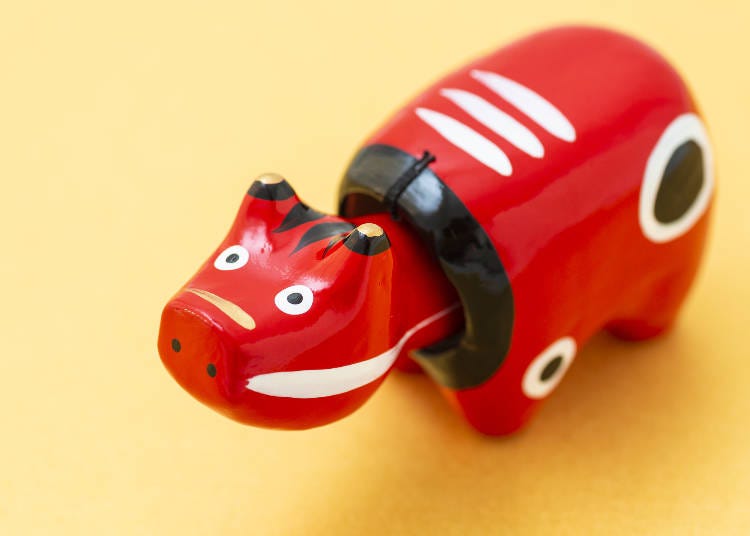
For lunch, check out Kuyoutei, one of the on-site restaurants serving local Aizu specialties such as kozuyu, a regional dish made with dried scallop dashi and various seasonal vegetables.
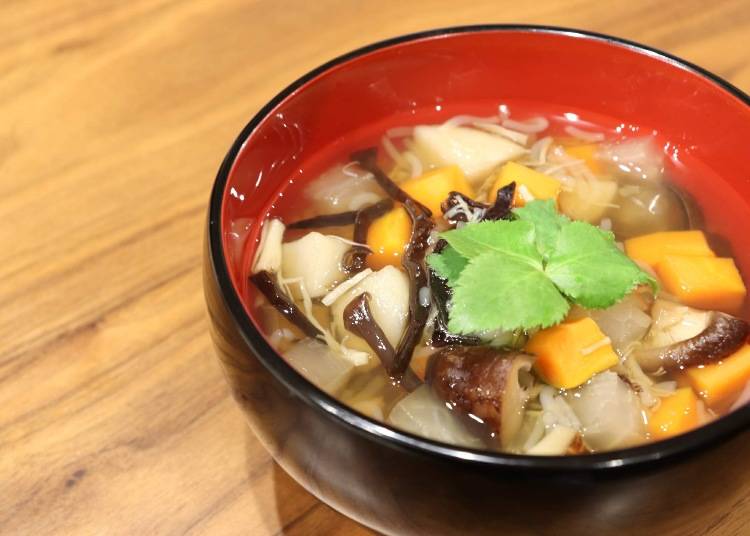
-
Aizu Bukeyashiki会津武家屋敷
- Address Innai-1-1 Higashiyamamachi Oaza Ishiyama, Aizuwakamatsu, Fukushima 965-0813
- Phone Number 0242-28-2525
・Open daily 8:30 AM - 4:55 PM
4. Sazaedo Temple: Complete a 2-month pilgrimage in 2 minutes!
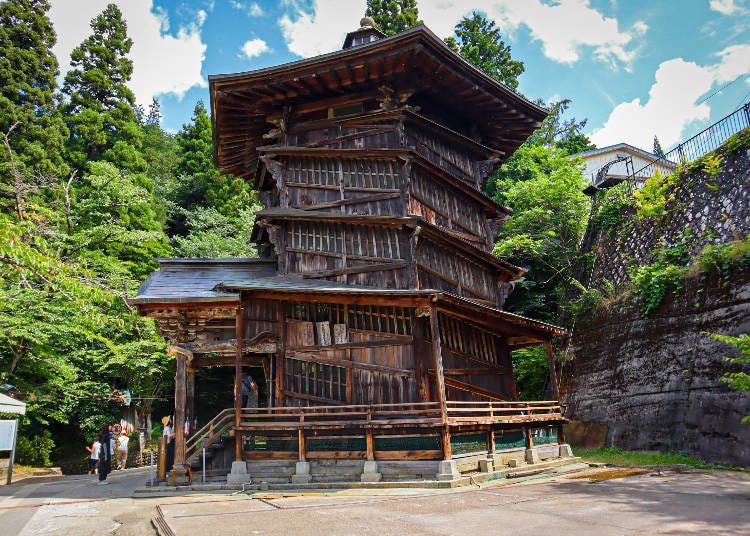
Get off the sightseeing bus at the base of Mt. Iimoriyama and pass through the souvenir street to reach the path of 183 stairs that leads to Sazaedo Temple. While the stairs are quite steep, there is a paid moving walkway (up only) to the right that can take you to the top without breaking a sweat for 250 yen/person.
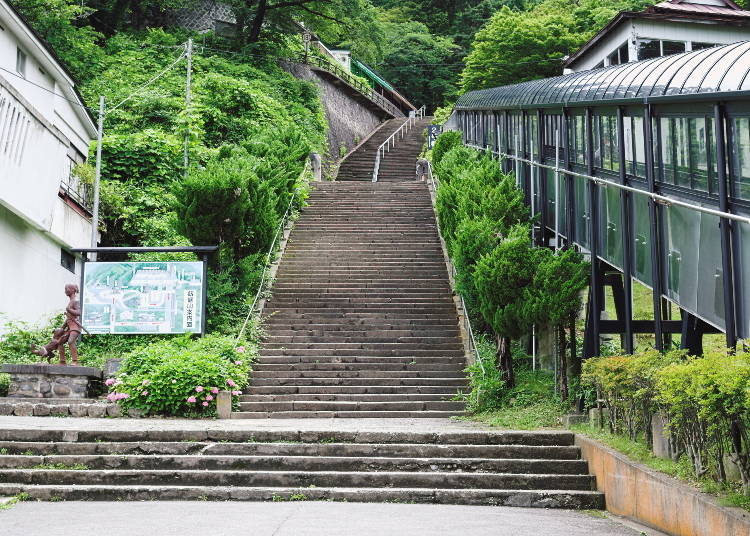
Once you reach the top, you cannot miss Sazaedo Temple. This uniquely-shaped Buddhist temple was built entirely out of wood in 1796, earning it the nickname “Sazaedo” for its resemblance to the spiral shell of a horned turban (sazae). The only temple in Japan with this unique design, Sazaedo is designated as an Important Cultural Property.
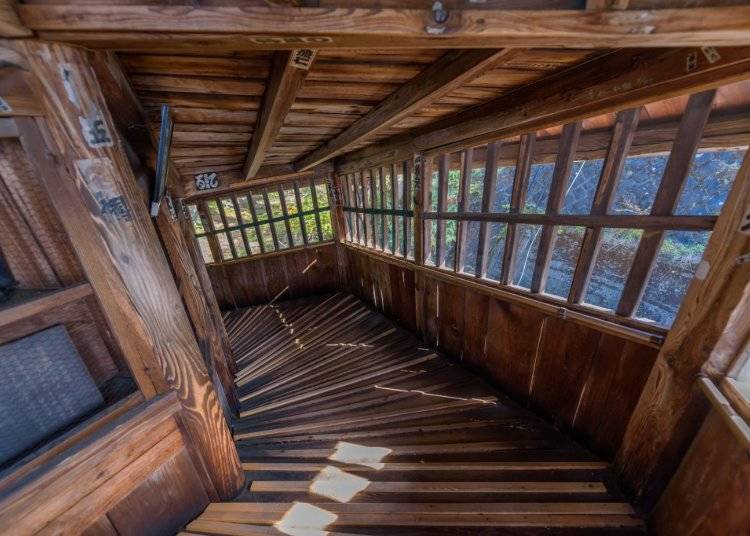
What you’ll find inside is even more perplexing - a double-helix spiral staircase that leads up and down the pagoda, but no floors. Along the climb you will pass 33 statues of Kannon, the bodhisattva of mercy. The monk who designed the temple wanted to replicate the Saigoku 33 Kannon Pilgrimage, a grueling route that passes through 7 prefectures and takes months to complete, so that ordinary people could pay respects to all 33 Kannon in a matter of minutes. The countless senjafuda - colorful paper stickers used by pilgrims as proof of their visit - pasted on the ceiling and walls of the temple stand as a testament to the monk’s success.
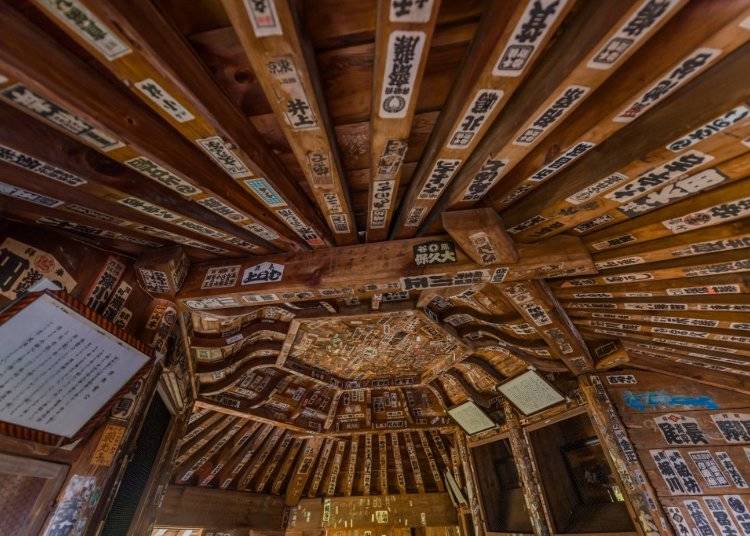
-

-
Address
155, Takizawa, Ikkimachiyahata, Aizuwakamatsu-shi, Fukushima, 965-0003
View Map -
Nearest Station
Aizu-wakamatsu Station (Tadami Line / Ban-etsusai Line)
5 minutes by bus
- Phone Number 0242-22-3163
-
Address
155, Takizawa, Ikkimachiyahata, Aizuwakamatsu-shi, Fukushima, 965-0003
5. Graves of the Byakkotai: A memorial to the dark history of samurai
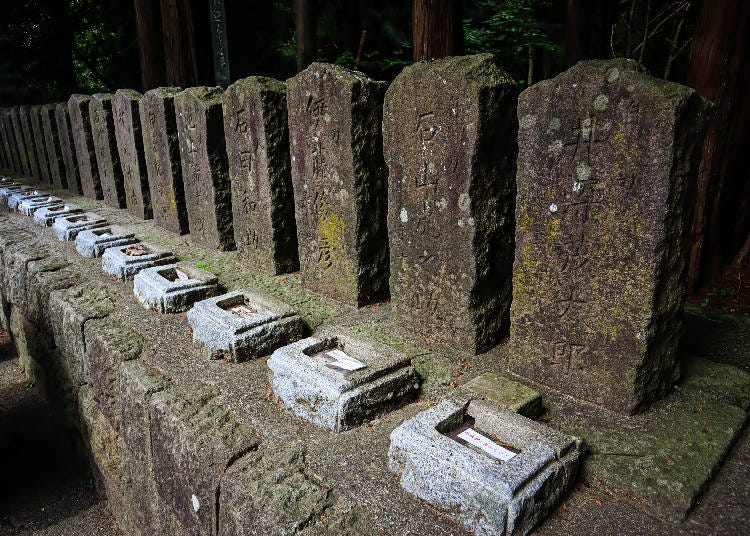
Nearest Bus Stop: Iimoriyama Shita A5/H36 (5-minute walk)
A stark contrast to the fun atmosphere of Sazaedo Temple, the surrounding grounds tell the story of a dark and harrowing past. Beside the temple, you will find a statue of a samurai, commemorating the tragic fate of a group of young warriors in the Byakkotai (White Tiger Corps) who took their lives on the mountain in 1868. The group consisted of around 300 members ranging from ages 15 to 17, and was meant to be a reserve unit during the Boshin War in the fight against the Imperialist forces.
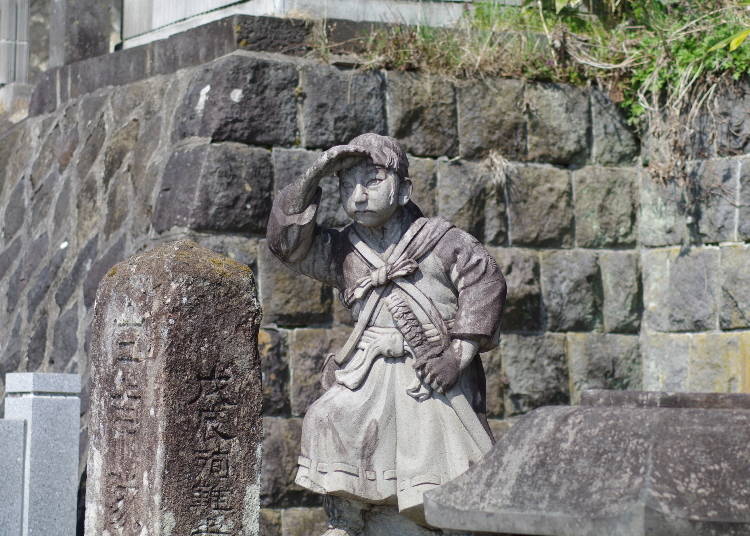
Cut off from the rest of their unit during a battle, 20 of the boys retreated up Mt. Iimoriyama, overlooking the castle town. Mistaking smoke rising from the castle as a sign of defeat, and believing that their lord and families had been killed, the boys gathered and committed seppuku - ritual suicide. Little did they know that the castle would still hold out for another two weeks. Their graves are at the summit of the mountain, the spot serving as a memorial for the young samurai and commemorates their ultimate sacrifice and show of loyalty. Visitors come daily to pay their respects and look out over the same landscape that the boys saw that day.
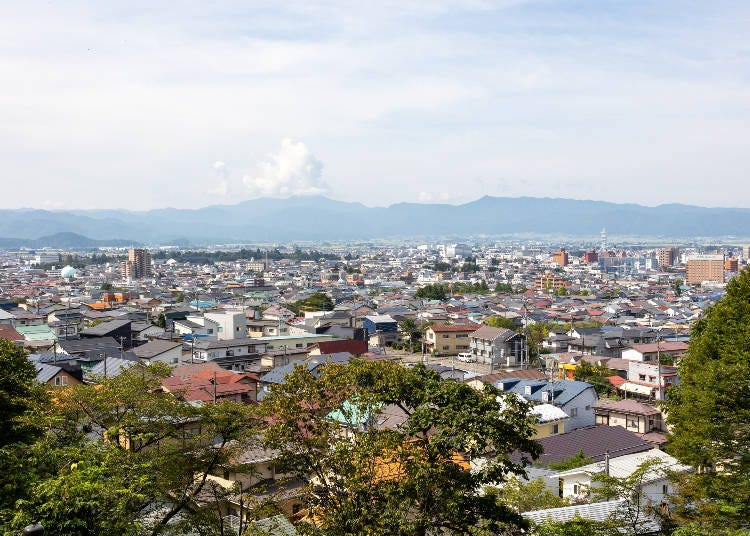
-
Graves of the Byakkotai "White Tiger Force"白虎隊士十九士の墓
- Address Takizawa-155 Itsukimachi Oaza Yahata, Aizuwakamatsu, Fukushima 965-0003
6. Kagota: The locals’ favorite bar
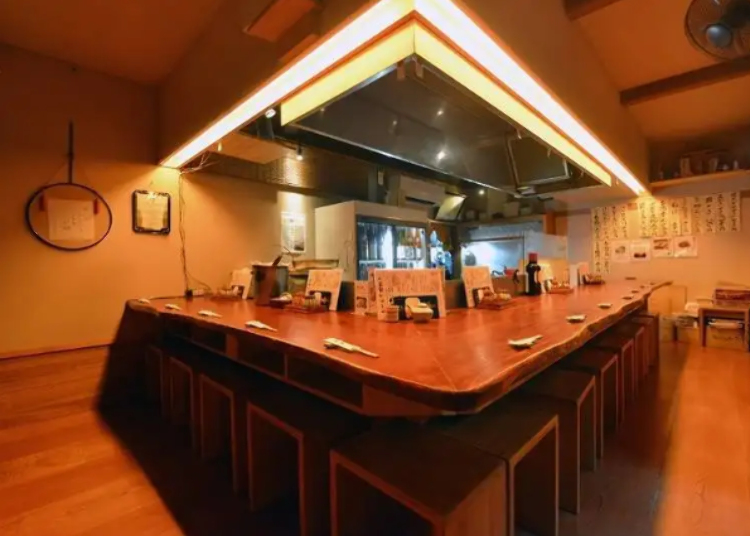
Nearest Bus Stop: Aizuwakamatsu City Hall H12/A29 (3-minute walk)
Ready for dinner yet? Look no further than Izakaya Kagota. This izakaya (casual Japanese bar) is one of the most famous in Aizu-Wakamatsu. Originally just a restaurant, the owner transformed Kagota into an izakaya about 30 years ago, creating a space in the community to come together and enjoy the highest-quality local ingredients paired with the finest local sake.
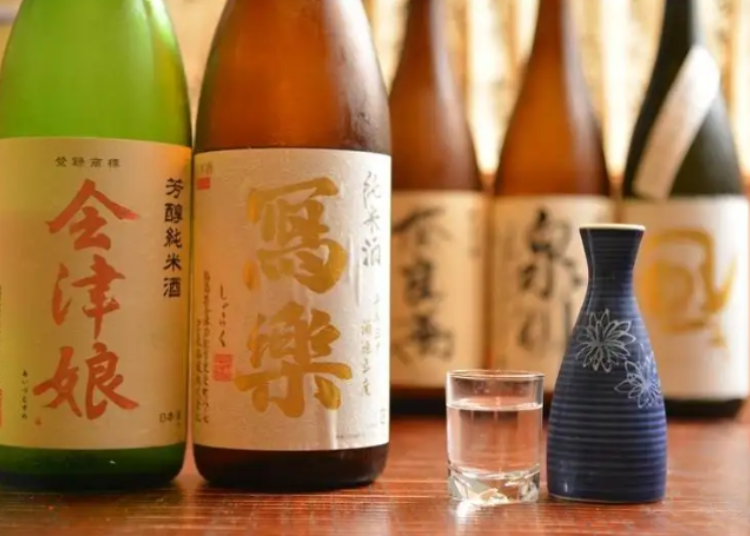
We recommend trying the fresh horse meat, locally-raised Aizu chicken, kozuyu (soup made with scallop dashi and various seasonal vegetables), and Nishino-no-sansho-zuke (pickled herring). Ask the master for his local sake recommendation for the perfect pairing!
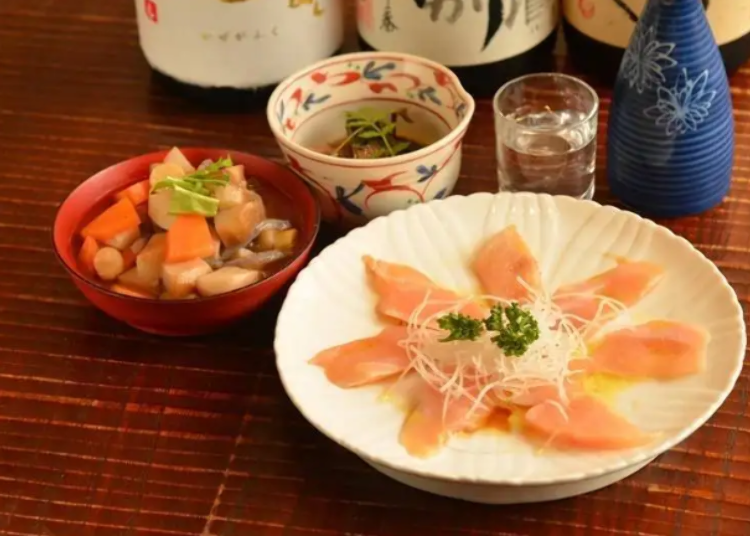
-
Kagota居酒屋籠太
- Address 8-49 Sakaemachi, Aizuwakamatsu, Fukushima 965-0871
- Phone Number 0242-32-5380
・Hours: 5 PM - 10 PM
・Closed: Wednesdays
・Website: http://www.kagota.co.jp/
7. Aizu Shurakukan Watanabe Shouta Shoten: THE place to buy Aizu sake
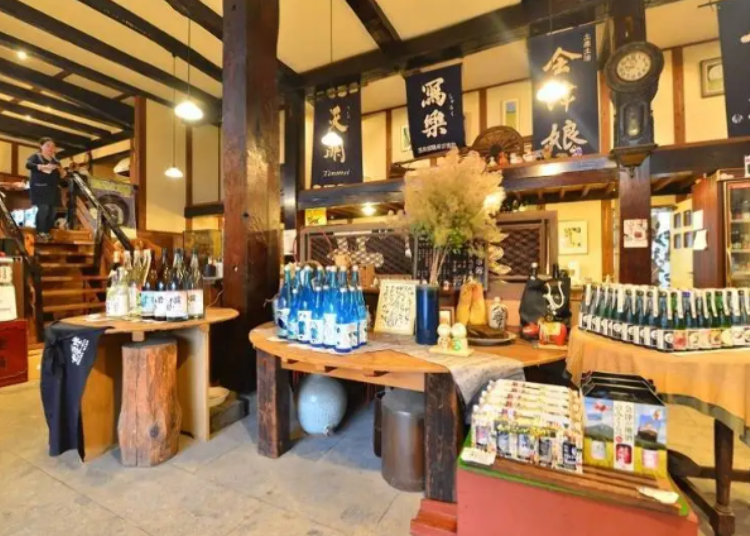
Nearest Bus Stop: Aizuwakamatsu Station H1/A1 (5-minute walk)
Before heading home, check out this large sake shop next to Aizu-Wakamatsu Station for last-minute souvenirs. With little-to-no information in English, Aizu Shurakukan is often overlooked by English-speaking visitors, but you are sure to find your perfect sake match on the shelves here.
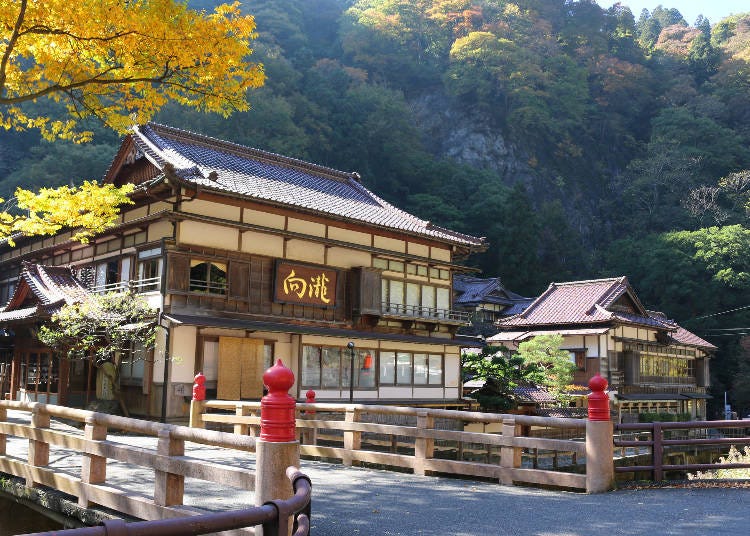
The storage room temperature is meticulously monitored year-round, ensuring the highest quality. Stocked with both classic and seasonal specialties, Aizu Shurakukan is serious about providing only the best local sake to its customers. The staff are more than happy to share their recommendations and their love of sake with visitors - just make sure that you leave enough room in your suitcase!
-
Aizu Shurakukan Watanabe Shouta Shoten會津酒楽館 渡辺宗太商店
- Address 350 Byakkomachi, Aizuwakamatsu, Fukushima 965-0024
・Hours: 9 AM - 7 PM
・Closed: Tuesdays
・Website: https://www.souta-shoten.com/
Where to stay in Aizu-Wakamatsu
From budget-friendly hotels to lavish Japanese inns, Aizu-Wakamatsu has an accommodation for every traveler. We recommend heading to Higashiyama Onsen hot spring district for the nicest Japanese inns, or staying in the city center for conveniently located Western-style hotels.
Aizu Higashiyama Onsen Mukaitaki
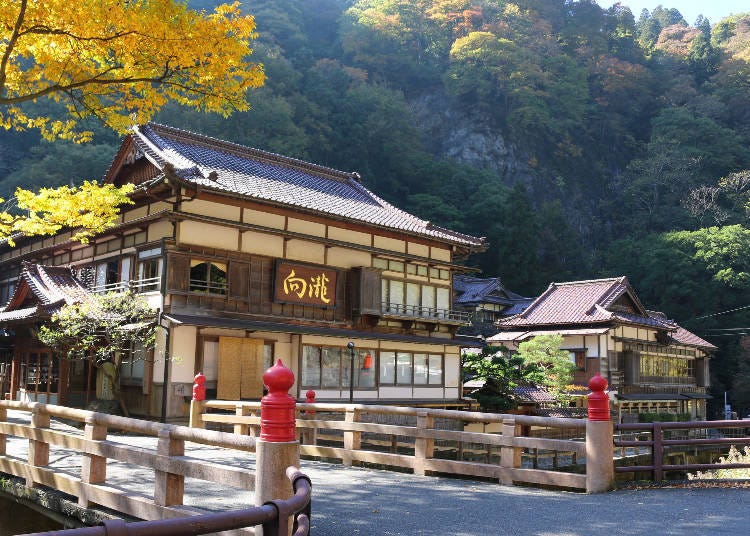
Mukaitaki is a ryokan (traditional Japanese inn) located in the historic Higashiyama Onsen hot spring district.
Once used as a recreational hot spring facility for samurai of the Aizu Clan, this historic inn will transport you back in time to the Edo period. Featuring stunning wooden architecture, a Japanese garden, natural onsen (hot springs), and meals made with local ingredients and paired with local sake, Mukaitaki is the logical conclusion to a day enjoying the wonders of Aizu-Wakamatsu. Rooms are traditional Japanese-style and the onsen features communal and private indoor baths.
-

-
Address
200, Kawamukai, Higashiyamamachiyumoto, Aizuwakamatsu-shi, Fukushima, 965-0814
View Map -
Nearest Station
Aizu-wakamatsu Station (Tadami Line / Ban-etsusai Line)
15 minutes by bus
- Phone Number 0242-27-7501
-
Address
200, Kawamukai, Higashiyamamachiyumoto, Aizuwakamatsu-shi, Fukushima, 965-0814
Shosuke-no-Yado Takinoyu
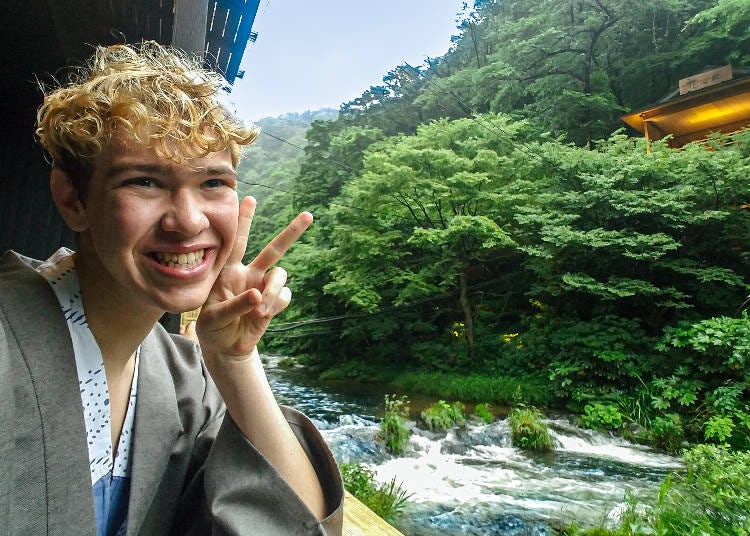
Nearest Bus Stop: Higashiyama Onsen Iriguchi (Takinoyu-mae) H28/A15 (1-minute walk)
Another ryokan in the Higashiyama Onsen area, this beautiful and spacious inn features Japanese-style rooms, as well as indoor, outdoor, and private onsen with scenic views of the waterfalls outside. The number of onsen alone makes Takinoyu one of our top picks for accommodations in Aizu-Wakamatsu.
-

-
Address
108 Higashi Yamamachi Yumoto, Aizuwakamatsu-shi, Fukushima, 965-0814
View Map -
Nearest Station
Nishi-wakamatsu Station (Tadami Line / Aizu Tetsudo Aizu Line)
-
Address
108 Higashi Yamamachi Yumoto, Aizuwakamatsu-shi, Fukushima, 965-0814
Hotel Route-Inn Aizuwakamatsu
Nearest Bus Stop: Aizutandai Minamiguchi H37/A4 (9-minute walk)
Standard, Western-style hotel on the east side of Aizu-Wakamatsu, with the added benefits of an indoor onsen and a free breakfast buffet. This is a solid, budget-friendly option without cutting any corners when it comes to comfort.
-

-
Address
1-5 Heianmachi, Aizuwakamatsu-shi, Fukushima, 965-0026
View Map -
Nearest Station
Aizu-wakamatsu Station (Tadami Line / Ban-etsusai Line)
25 minutes on foot
-
Address
1-5 Heianmachi, Aizuwakamatsu-shi, Fukushima, 965-0026
Aizuwakamatsu Washington Hotel
Nearest Bus Stop: Aizuwakamatsu Station H1/A1 (4-minute walk)
Budget-friendly, Western-style hotel conveniently located near Aizu-Wakamatsu Station and Aizuwakamatsu Station Bus Stop. The classy restaurant and bar on the top floor offer panoramic views of the city below.
-

-
Address
201 Byakkomachi, Aizuwakamatsu-shi, Fukushima, 965-0024
View Map -
Nearest Station
Aizu-wakamatsu Station (Tadami Line / Ban-etsusai Line)
6 minutes on foot
-
Address
201 Byakkomachi, Aizuwakamatsu-shi, Fukushima, 965-0024
Is Aizu-Wakamatsu Worth It?
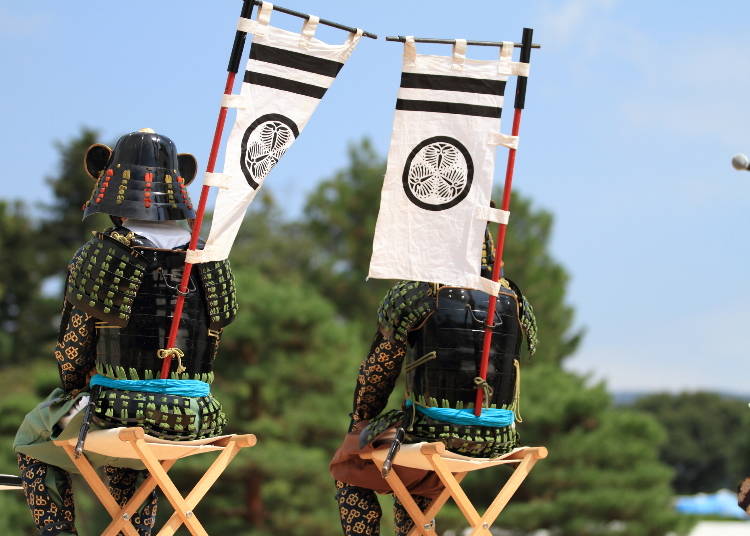
Only 3 hours from Tokyo and blessed with one of the most convenient sightseeing bus routes we’ve ever seen, the answer is a resounding yes. While the area is beautiful in every season, we recommend visiting in the mild spring or autumn to beat the oppressive summer heat and frosty winter winds.
Catch Aizu-Wakamatsu blanketed in pink cherry blossoms in mid-April, or the yellow and red hues of autumn foliage from late October to mid-November.
- Tsurugajo Castle Sakura Festival (early April to early May)
- Aizu Tajima Gion Festival (late July)
- Aizu Festival (late September)
- Aizu Painted Candle Festival (early February)
Recommended tours of Aizu-Wakamatsu
Whether you’re planning a multi-day stay or a one-day trip, the historic samurai culture and deliciously smooth sake of Aizu-Wakamatsu is sure to become the highlight of your time in Japan!

Expedition Japan
Sarah Dean is a tourism professional with over 6 years in Japan, 5 of which spent living in and exploring the Tohoku region. Passionate about connecting off-the-beaten-path destinations in Japan with the rest of the world, she served as Coordinator for International Relations in Yamagata for four years, later transitioning to Director of Inbound Promotion at Expedition Japan. She has visited 33/47 prefectures and counting, and collaborates with local government bodies in the development of tourism infrastructure in rural areas. She is a Nationally Licensed Tour Conductor, certified highest level of the Japanese Language Proficiency Test (N1), and holds a Bachelor’s Degree in Japanese from Western Washington University.
- Area
- Category
*Prices and options mentioned are subject to change.
*Unless stated otherwise, all prices include tax.
Popular Tours & Activitiess
Recommended places for you
-

Geibikei Gorge
Rivers, Lakes & Canyons
Morioka, Hiraizumi And Hachimantai
-

Akiu Onsen
Hot Springs (Onsen) & Bath Houses (Sento)
Sendai And Matsushima
-

Zuiganji Temple
Temples
Sendai And Matsushima
-
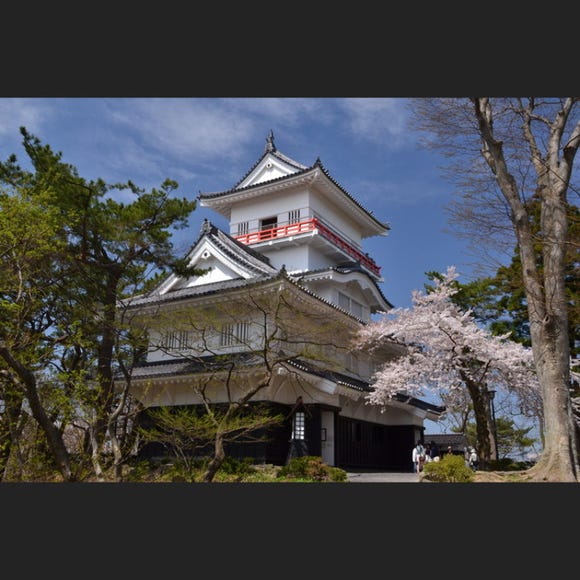
Senshu Park
Parks
Surrounding Areas Of Akita
-
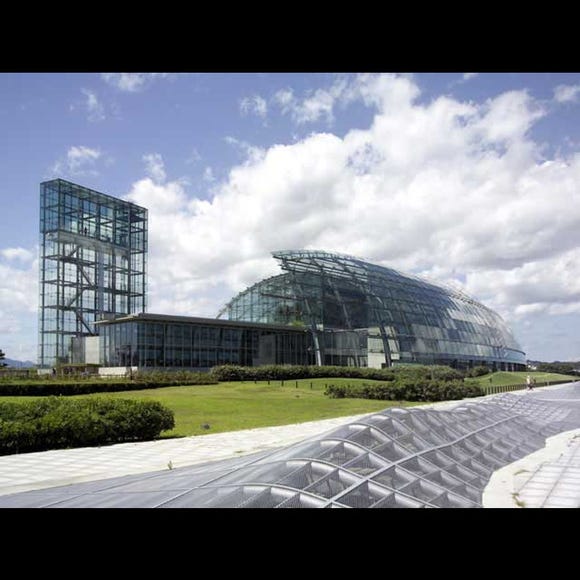
Aquamarine Fukushima
Zoos, Aquariums & Botanical Gardens
Fukushima, Koriyama And Iwaki
-
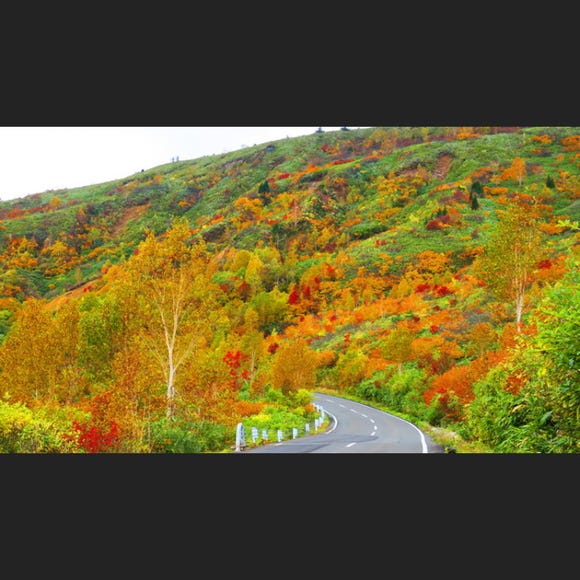
Hachimantai Aspite Line
Landscapes
Morioka, Hiraizumi And Hachimantai
-

Shopping in Niigata: 9 Must-Buy Souvenirs & Local Sake to Take Home
by: ShiroKu inc.
-

Niigata Sake no Jin 2026: Guide to Japan's Most Legendary Sake Weekend
-

Aomori's Quiet Side in Autumn: 5 Scenic Spots in Hachinohe According to a Local
by: Marco Blasco
-
Ad

Advice from the Experts at Hitohira: Here's How to Choose the Best Japanese Knife
-

Smart Ways to Avoid Crowds and Enjoy a Safe, Comfortable Trip to Myoko, Niigata Prefecture.
-
Ad

Why Fukushima is the Next Big Food Destination in Japan The Foodie Paradise Only 90 Minutes from Tokyo
-

Hasshoku Center: Enjoy Famous Seafood Bowls at Aomori's Giant Fish Market
-

10 Must-Visit Places for Autumn Leaves in Tohoku: Naruko Gorge, Geibikei Gorge & More (2025)
by: Guest Contributor
-

Yamagata Prefecture Guide: Destinations, Activities, Travel Advice, Shopping & More
by: Steve Csorgo
-

6 Surprisingly Cheap Things in Japan
-

8 Unfamiliar (But Totally Normal) Customs in Japan!
-

Kichijoji – Explore Tokyo’s Top-Rated Stylish Suburb in Half a Day!













